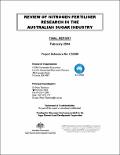| Abstract | The management of nitrogen (N) fertiliser is important to the Australian sugar industry, as it is an important nutrient for sugarcane production. However, over application results in reduced profitability and sugar quality, and results in high concentrations of N in soils and water of sugarcane growing areas. An extensive review of current and past research on N fertiliser management in the Australian sugar industry was undertaken to identify possible improvements in N fertiliser management and establish priorities for future research into sustainable management of N fertiliser. The Australian sugar industry has a history of high N fertiliser usage, with applications increasing from the 1960s to the late 1990s. However, industry average sugarcane production has not kept pace with N fertiliser applications, resulting in a steady increase in N fertiliser applied per ton of sugarcane harvested. Historical and recently developed N management strategies rely on matching N applications to the predicted/expected yield of the forthcoming crop. Over-application of N fertiliser is a rational reaction by growers to uncertainty about the size of the coming crop and the long-term impact of N fertiliser on profitability – significant over-fertilisation reduces profits much less than significant under fertilisation. We suggest that past and current N fertiliser management strategies have not adequately accounted for these attitudes, and the resultant longer-term implications for soil and water quality and environmental impacts in sugarcane catchments. While long-term under application of N fertiliser undoubtedly reduces profitability, there is considerable evidence to show that greatly reducing N fertiliser applications for a single crop will not significantly reduce sugarcane production. Thus, the short-term risk of crop yields limited by N deficits is possibly much lower than generally appreciated. If this is so, a new philosophy of N fertiliser management can be developed that remove the uncertainties that drive growers to over-apply N, and so allow closer matching of N inputs to N outputs from a sugarcane system. Rather than aiming to fertilise the coming crop, it may only necessary to replace the N lost from the previous crop, the majority of which is in harvested cane and therefore be easily estimated. Over the past decade, there have been significant advances in our ability to simulate N (and carbon) dynamics in sugarcane production systems. We drew upon these advances to undertake a ‘desktop’ examination of this new ‘replacement’ N management strategy. Three N management scenarios were simulated: (1) the ‘replacement’ strategy, (2) the current recommended strategy and (3) the average amounts of N applied in the industry (i.e., 30 % greater than those recommended). The replacement strategy had similar productivity, greater profitability and lower environmental N losses, whether we simulated potential crop production or a more realistic level of production (resulting from the impact of pests, diseases, lodging, stool damage, etc.). Moreover, these advantages were greater in the simulations of realistic yields. The ‘replacement’ strategy is an evidence based, transparent and defensible N management strategy, all attributes that are important for the sugar industry to maintain self-regulation of N fertiliser management. We suggest that this strategy warrants further testing, through both simulation and field experiments. |

